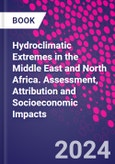Hydroclimatic Extremes in the Middle East and North Africa: Assessment, Attribution and Socioeconomic Impacts focuses on assessing the current situation of hydroclimatic extremes in the MENA region, with particular emphasis on dry and wet extreme events. The results of the rapidly changing atmospheric and oceanic situations of these extremes will be addressed, presenting examples for the environmental, socioeconomic, and cultural impacts of these events in the region and evaluating the current ability to monitor and adapt to such events, as well as exploring the potential use of advanced geospatial techniques in improving current understanding of these extreme events.
The book utilizes a multidisciplinary approach with various state-of-the-art methods, approaches, and analytical techniques in environmental, meteorological, and hydrological sciences, providing case studies from the Middle East and North Africa. It will provide a solid basis for scientists to assess the validation of several research methods in the region and may be applicable to other regions as climate change continues to cause increasing aridity worldwide. The case studies presented will reflect the multifaceted character of hydrometeorological extremes in the region, with representative examples for the environmental, socioeconomic, and cultural impacts of climate change. Therefore, this book is a valuable source for climatologists, meteorologists, hydrologists, geographers, and water resources scientists.
Please Note: This is an On Demand product, delivery may take up to 11 working days after payment has been received.
Table of Contents
1.Hydroclimatic extremes in arid and semi-arid regions: status, challenges, and future outlook2.How warming in East Mediterranean may contribute to Sahara cyclogenesis
3.Links between climate and hydrological budget in arid environments: the case of Sinai Peninsula
4. Impacts of climate change on drought in Libya
5. Rainfall erosivity changes across the coastal region of Syria (1975-2010)
6.Drought prediction and mitigation in Algeria
7.Modeling and managing flash flood hazards in the state of Kuwait, hydrogeomorphological study
8.Rainfall characteristics in Egypt from 1960 to 2017: patterns, variability, driving mechanisms, and impacts
9.Urban climate of the middle east and north Africa region: a comprehensive anatomization
10.Analysis of surface urban heat island using nighttime MODIS LST data as a signal for regional climate change: a case study in Dubai city, the United Arab Emirates
11.Monitoring urbanization growth and its impacts on climatic changes over Greater Cairo (Egypt) using satellite images
12.Urban climate change in view of climate justice: case study Dokki Area, Giza, Egypt
13.Climate change and its impacts on selected archeological sites in Egypt
14.Impacts of surface heat islands on urban planning and sustainability in Egypt
15.A proposed model for sustainable cities against changing climate in Egypt
16.Extreme climate indices over Libya: current and future outlooks
17.The present and future variability of the temperature extreme indices of Sudan under RCP4.5 and RCP8.5 emission scenarios
18.The hydroclimate extreme indices in the northern coast of Egypt based on CMIP5 model projections
19.Natural hazards mapping of mega sea waves on the northwest coast of Egypt
20. Anomalous thermal conditions as precursors of significant earthquakes in Egypt: spatial gradients and temporal behavior








